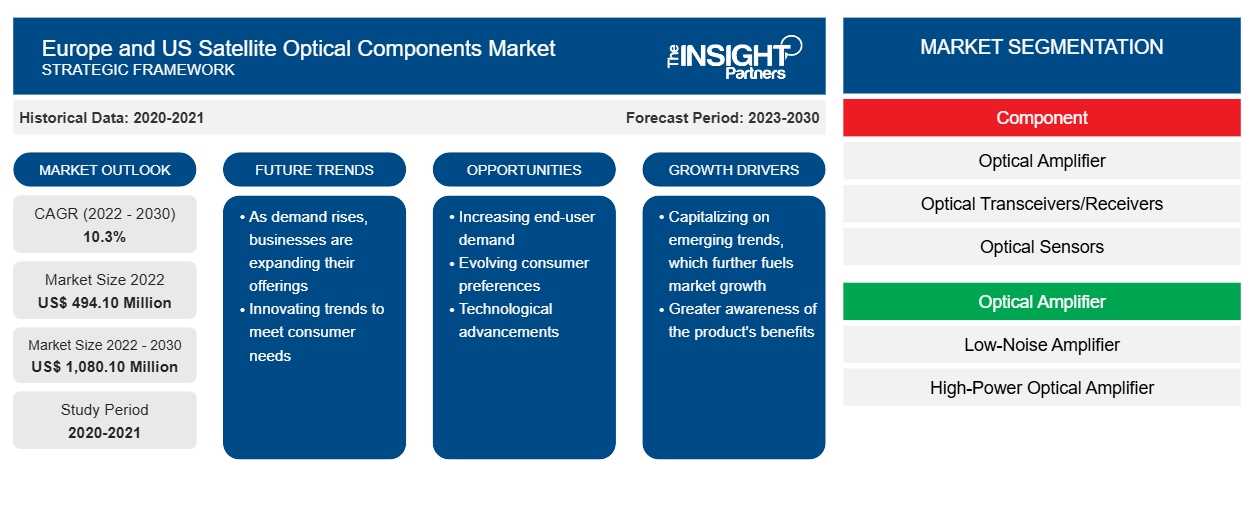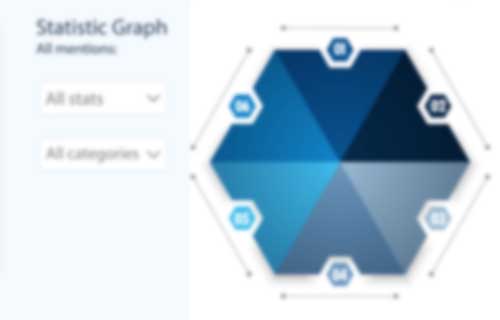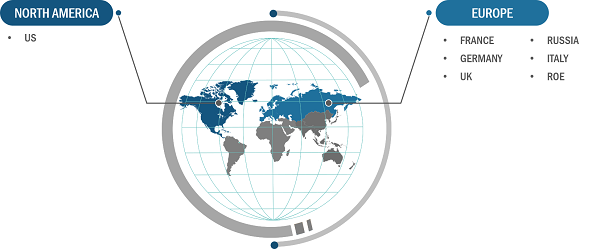The Europe and US satellite optical components market was valued at US$ 494.10 million in 2022 and is projected to reach US$ 1,080.10 million by 2030; it is expected to register a CAGR of 10.3% from 2022 to 2030.
Analyst Perspective:
The Europe and US satellite optical components market is a dynamic and pivotal sector within the broader satellite technology landscape. Many companies in European countries and the US are significantly focused on the development of advanced satellite optical components and contributing to enhancing cutting-edge satellite communication systems and earth observation capabilities. In recent years, there has been a surge in demand for high-performance optical components, driven by the increasing need for data-intensive applications, including high-resolution imaging, navigation, and broadband communication. European countries and the US have well-established, robust infrastructure for research and development, which aims to innovate and develop satellite optical components. The industry's focus includes developing lightweight, durable, and high-precision optical components that can withstand the harsh conditions of space. Ongoing advancements in materials and manufacturing processes contribute to improved performance and reliability. As global demand for satellite services continues to grow, the Europe and US satellite optical components market is anticipated to play a key role in driving the future of space-based technologies, impacting communication, earth observation, and scientific research on a global scale.
Market Overview:
The Europe and US satellite optical components market in Europe and the US is characterized by dynamic growth, technological innovation, and strategic collaborations. Key players such as Spectrum Control Inc, Skyworks Solutions Inc, Lumibird SA, CACI International Inc, and BridgeComm Systems contribute significantly to developing cutting-edge optical components for satellites. These optical components are integral to diverse satellite applications, including Earth observation, telecommunications, navigation, broadcasting, and scientific research. The European Space Agency (ESA) and the National Aeronautics and Space Administration (NASA) play pivotal roles, fostering collaborative initiatives and supporting research and development efforts.
The Europe and US satellite optical components market growth in Europe and the US is driven by the growing demand for high-resolution imaging, rising data-intensive applications, and expanding satellite-based services. Materials, manufacturing processes, and precision engineering advancements contribute to improved satellite performance and reliability. Europe and the US leverage their robust aerospace industries and engineering capabilities to stay at the forefront of satellite technology. In addition, the rise in investment in the space industry in Europe and the US is expected to boost the growth of the Europe and US satellite optical components market size in the coming years. For example, the European Union Space Program 2021–2027, launched in January 2021, aimed to provide high-quality and secure space-related data and services, secure satellite communications, and better navigation results.
Customize This Report To Suit Your Requirement
You will get customization on any report - free of charge - including parts of this report, or country-level analysis, Excel Data pack, as well as avail great offers and discounts for start-ups & universities
Europe and US Satellite Optical Components Market: Strategic Insights

-
Get Top Key Market Trends of this report.This FREE sample will include data analysis, ranging from market trends to estimates and forecasts.
Market Driver:
Rise in Investment Toward Satellite Launching Programs are Driving the Europe and US Satellite Optical Components Market
Increased funding in satellite launching programs reflects a growing emphasis on space exploration, satellite deployment, and space-based services. As more satellites are launched into orbit for applications such as communication, Earth observation, and navigation, there is a parallel surge in demand for advanced optical components. For instance, according to the United Nations Office for Outer Space Affairs (UNOOSA), 2,474 satellites were launched in 2022—compared to 1,810 in 2021 across the globe. These components play a key role in enhancing the capabilities of satellites, including improved imaging systems, high-speed data communication, and precise sensing. High investment in launching programs indicates a broader commitment to space technology, creating opportunities for optical component manufacturers to contribute to developing sophisticated satellite systems. Thus, the rising investment toward satellite launching programs drives the Europe and US satellite optical components market.
- This FREE sample will include data analysis, ranging from market trends to estimates and forecasts.
Segmental Analysis:
The optical amplifier segment held the largest share in the Europe and US satellite optical components market in 2022. Optical components are essential in astronomy and space exploration, allowing scientists to observe celestial objects and explore the universe. Optical components are also used in space-based telescopes and satellites, providing valuable data for scientific research and space exploration missions. For example, optical components such as amplifiers, sensors, transceivers/receivers, and amplifiers are used to generate, manipulate, and detect light signals in optical communication systems in satellite applications. These optical components enable efficient data transfer and high-speed Internet, fiber optic networks, and long-distance communications.


- This FREE sample will include data analysis, ranging from market trends to estimates and forecasts.
Regional Analysis:
The Europe and US satellite optical components market size is segmented into key regions, including Europe and the US. Europe registered the highest market share. The Europe and US satellite optical components market is dynamic and is experiencing strong growth characterized by technological innovation and strategic collaborations. With a strong emphasis on satellite communication and Earth observation, European countries have emerged as key players in advancing satellite optical technologies. Major industry contributors include leading aerospace companies such as Airbus and Thales Alenia Space, renowned for their expertise in developing cutting-edge optical components. These components are integral for the success of satellites for applications ranging from telecommunications to environmental monitoring. Thus, the presence of major industry contributors is driving the Europe and US satellite optical components market growth.
The Europe and US satellite optical components market benefits from collaborative initiatives facilitated by organizations such as the European Space Agency (ESA). These partnerships foster research and development, encouraging the exchange of knowledge and expertise among member states. The region's commitment to space exploration is evident in projects such as the Copernicus program, which emphasizes Earth observation and environmental monitoring. As demand for high-resolution imaging and data-intensive applications continues to rise, the Europe and US satellite optical components market in Europe is positioned to proliferate, contributing significantly to advancements in space technology and reinforcing Europe as a key region in the global space sector.
Several satellite constellation operators have been focusing on the development of different types of satellite ecosystems for various applications including communications, broadcasting, navigation, space exploration, and scientific research as well. Further, the growing number of satellite production and launches is also pushing the growth of Europe and US satellite optical components market.
Key Player Analysis:
Spectrum Control Inc, Skyworks Solutions Inc, Lumibird SA, CACI International Inc, Satellite Imaging Corp, Amphenol Corp, Exail SAS, Alter Technology TUV Nord SA, Bridgecom Systems Inc, and MACOM Technology Solutions Holdings Inc are among the key Europe and US satellite optical components market players with significant market share that are profiled in this Europe and US satellite optical components market study.
Recent Developments:
Inorganic and organic strategies such as mergers and acquisitions are highly adopted by companies operating in the Europe and US satellite optical components market. A few recent developments by key Europe and US satellite optical components market players in the market are listed below:
Year |
News |
Region |
|
September, 2023 |
CACI International completed Optical Communication Terminal (OCT) Interoperability Testing (OIT) for its CrossBeam OCT for the Space Development Agency's Tranche 1 data relay and tracking network. CACI was the first SDA-compliant terminal to set up a consistent data communication link with the reference modem. The testing was part of a team led by Lockheed Martin to build 42 satellites for SDA's Tranche 1 Transport Layer (T1TL), a mesh network of 126 optically interconnected space vehicles. |
North America |
|
December, 2023 |
Thales Alenia Space, the joint venture between Thales (67%) and Leonardo (33%), has signed a multi-mission contract with PT Len Industri to provide a state-of-the-art Earth observation constellation combining both radar and optical sensors, which is dedicated to the Indonesian Ministry of Defense (MoD). |
North America |
Europe and US Satellite Optical Components Report Scope
| Report Attribute | Details |
|---|---|
| Market size in 2022 | US$ 494.10 Million |
| Market Size by 2030 | US$ 1,080.10 Million |
| CAGR (2022 - 2030) | 10.3% |
| Historical Data | 2020-2021 |
| Forecast period | 2023-2030 |
| Segments Covered |
By Component
|
| Regions and Countries Covered |
Europe
|
| Market leaders and key company profiles |
|
Frequently Asked Questions
What are reasons behind the Europe and US satellite optical components market growth?
What are market opportunities for the Europe and US satellite optical components market?
Who are the major vendors in the Europe and US satellite optical components market?
Which region to dominate the Europe and US satellite optical components market in the forecast period?
What is the future trend for the Europe and US satellite optical components market?
- Historical Analysis (2 Years), Base Year, Forecast (7 Years) with CAGR
- PEST and SWOT Analysis
- Market Size Value / Volume - Regional, Country
- Industry and Competitive Landscape
- Excel Dataset
Recent Reports
Testimonials
Reason to Buy
- Informed Decision-Making
- Understanding Market Dynamics
- Competitive Analysis
- Identifying Emerging Markets
- Customer Insights
- Market Forecasts
- Risk Mitigation
- Boosting Operational Efficiency
- Strategic Planning
- Investment Justification
- Tracking Industry Innovations
- Aligning with Regulatory Trends





















 Get Free Sample For
Get Free Sample For